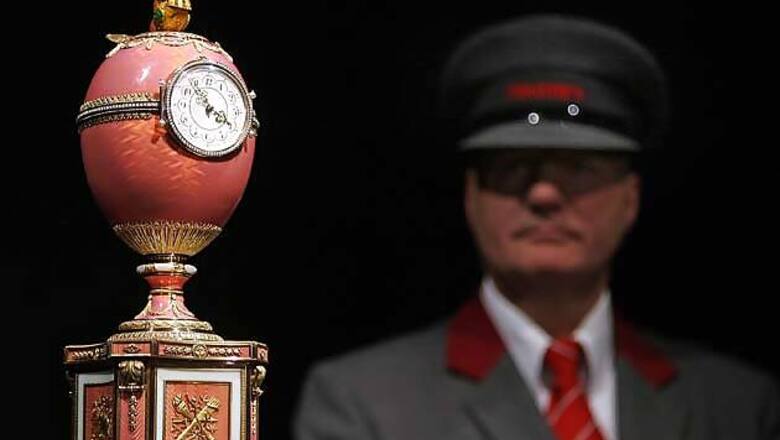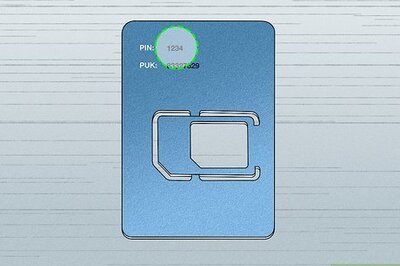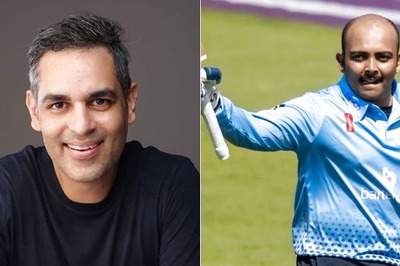
views
New Delhi: Six gilded Easter eggs adorn the Google home page to mark master Russian jeweller Peter Carl Faberge's 166th birthday.
Faberge was the court jeweller for the last two Russian Czars and the bejewelled Easter eggs were his speciality. Since the very first egg that contained a jewelled hen in 1885 Faberge made a total of 54 eggs in 37 years for the Romanovs.
Only 47 of the Fabergé eggs are believed to have survived. Nine of the famous Imperial Fabergé eggs were displayed in India during an exhibition in late 2008.
It is not that Peter Carl Fabergé designed bejewelled eggs only for the Russian royals, a select few prominent families and individuals also had Fabergé specially made for them.
####Images of some of Peter Carl Faberge’s famed eggs:

The Renaissance Faberge egg is displayed during the exhibition ”Treasures of Imperial Russia” in Croatia’s Adriatic town of Dubrovnik on November 3, 2007. The egg of gold, diamonds, rubies, white agat and enamel was presented by Emperor Alexander 3rd to his wife Empress Maria Feodorovna for Easter 1894. Reuters/Nikola Solic

June 1935: Richly decorated and highly-ornate Faberge eggs, embellished with gold and precious stones, pictured as part of a Russian Art exhibition. Topical Press Agency/Getty Images

The ”Memory of Azov” egg by Faberge sits on display in the Kremlin April 6, 2011. Reuters/Alexander Natruskin

The Coronation Egg by Faberge is seen on display during the exhibition in the Kremlin in Moscow, May 18, 2004. Reuters/Sergei Karpukhin

The Rothschild Faberge egg is displayed at Christie’s auction house in London October 4, 2007. Reuters/Kieran Doherty

The Bay Tree Faberge egg is displayed during the exhibition ”Treasures of Imperial Russia” in Croatia’s Adriatic town of Dubrovnik on November 3, 2007. The egg of gold, nephrite, quartz, diamonds, rubies, amethyst, citrines and pearls was presented by Emperor Nicholas 2nd to his mother, Dowager Empress Maria Feodorovna for Easter 1911. Reuters/Nikola Solic

The Order of St. George Faberge egg is displayed during the exhibition ”Treasures of Imperial Russia” in Croatia’s Adriatic town of Dubrovnik on November 3, 2007. The egg of gold, silver, enamel and water-color on ivory was presented by Emperor Nicholas 2nd to his mother Dowager Empress Maria Feodorovna for Easter 1916. Reuters/Nikola Solic

A masterpiece faberge winter egg made for Russia’s imperial family sold for 7.2 million Swiss francs ($5.5 million US dollars) at Christie’s auction house in Geneva November 16 to an anonymous buyer. The sale was a record for a Faberge egg. Reuters

A visitor admires the Egg by Faberge, presented by the Russian Czar Nikolas II to his wife in 1911, during an exhibition in the Kremlin in Moscow, May 18, 2004. Reuters/Sergei Karpukhin

A visitor admires precious richly decorated eggs at an opening of Faberge Grand Collection Gallery in central Moscow near the Kremlin, October 25, 2005. Reuters/Viktor Korotayev

Visitors look at the baroque Cockerel Faberge Imperial Easter egg at the exhibition ”Faberge in Berlin – Treasures of the Imperial Russia” at Charlottenburg Palace in Berlin, June 15 2005. The Cockerel or Cuckoo Egg is one of six Faberge Imperial Easter eggs with embedded mechanics, which reveals a bird flapping its wings and crowing. Reuters

The ”Alexander III Monument” egg by Faberge sits on display in the Kremlin April 6, 2011. Reuters/Alexander Natruskin

The 1914 Faberge Mosaic Egg, one of four Faberge eggs among the Royal Collection of Britain’s Queen Elizabeth ll, is pictured in London November 20, 2003. Reuters/Kirsty Wigglesworth/Pool

Lily of the Valley Egg by Faberge is admired by visitors at the exhibition in the Kremlin in Moscow, May 18, 2004. Reuters/Sergei Karpukhin

Judy Coombes (R) and Susan McMunn look at the 1906 Moscow Kremlin Egg, the largest Faberge Easter egg on display in the exhibition ”Treasures from the Kremlin: The World of Faberge” at Sydney’s Powerhouse Museum. Reuters


















Comments
0 comment